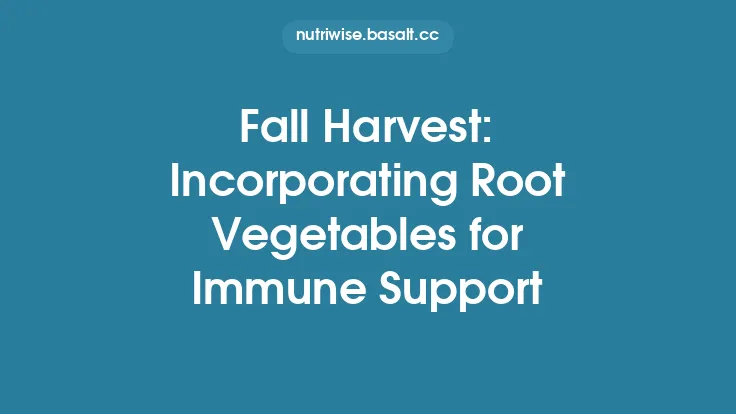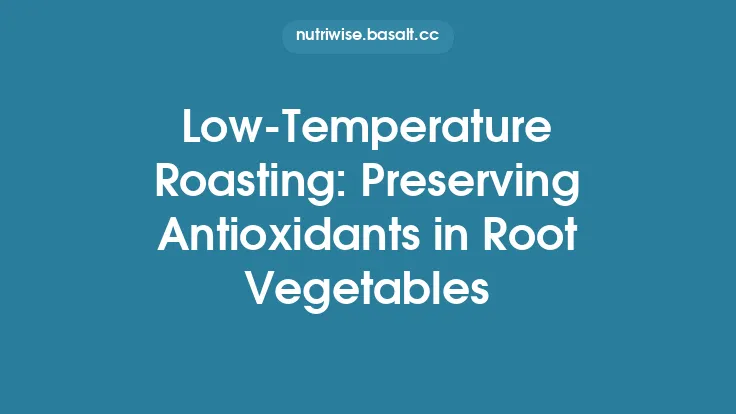Root vegetables such as carrots, parsnips, beets, turnips, and sweet potatoes are nutritional powerhouses that deliver complex carbohydrates, a spectrum of vitamins, and, most importantly for blood‑sugar management, a substantial amount of dietary fiber. When roasted with a thoughtful blend of fiber‑boosting herbs—think rosemary, thyme, sage, and oregano—the resulting dish not only satisfies the palate but also creates a synergistic effect that helps blunt post‑prandial glucose spikes. This article walks you through the science behind the interaction of fiber and phytochemicals, the optimal roasting parameters that preserve nutrient integrity, and practical strategies for incorporating this versatile side into a blood‑sugar‑friendly eating plan.
Understanding the Glycemic Impact of Root Vegetables
| Root Vegetable | Approx. Net Carbs (g) per 100 g | Dietary Fiber (g) per 100 g | Typical GI* |
|---|---|---|---|
| Carrot (raw) | 4.7 | 2.8 | 35‑45 |
| Parsnip (raw) | 14.0 | 4.9 | 52‑55 |
| Beet (raw) | 6.8 | 2.8 | 61‑64 |
| Turnip (raw) | 4.6 | 1.8 | 30‑35 |
| Sweet potato (raw) | 17.0 | 2.5 | 44‑61 |
\*GI values can vary with preparation method; roasting generally raises the GI modestly compared with raw or boiled forms, but the effect can be mitigated by fiber and herb inclusion.
The key to stabilizing glucose lies in the net carbohydrate (total carbs minus fiber) and the rate of gastric emptying. Fiber slows enzymatic breakdown, while certain herb compounds can influence intestinal glucose transporters, further dampening the rise in blood sugar.
The Role of Fiber‑Boosting Herbs
| Herb | Primary Bioactive Compounds | Fiber Content (g) per 10 g (dry) | Blood‑Sugar‑Relevant Actions |
|---|---|---|---|
| Rosemary | Carnosic acid, rosmarinic acid | ~30 | Inhibits α‑glucosidase, modestly reduces glucose absorption |
| Thyme | Thymol, luteolin | ~28 | Enhances insulin signaling pathways |
| Sage | Rosmarinic acid, caffeic acid | ~25 | Delays gastric emptying, improves peripheral glucose uptake |
| Oregano | Carvacrol, thymol | ~27 | Suppresses post‑prandial glucose spikes via GLUT2 modulation |
Although the absolute fiber contributed by a typical herb sprinkle is modest, the phytochemical synergy amplifies the overall glycemic benefit. Moreover, the aromatic profile encourages satiety, which can reduce overall caloric intake.
Selecting the Right Oil and Seasoning Balance
Roasting inevitably involves a fat source to promote Maillard browning and improve mouthfeel. Choose oils that are low in saturated fat and high in monounsaturated or polyunsaturated fats, as these fats have a neutral or slightly beneficial effect on insulin sensitivity.
| Oil | Smoke Point (°C) | Fat Profile | Recommended Quantity for 1 kg veg |
|---|---|---|---|
| Extra‑virgin olive oil | 190‑210 | 73 % MUFA, 11 % PUFA | 2 Tbsp (≈30 mL) |
| Avocado oil | 260‑270 | 70 % MUFA, 13 % PUFA | 1.5 Tbsp |
| High‑oleic sunflower oil | 225‑230 | 80 % MUFA, 5 % PUFA | 2 Tbsp |
A light coating—just enough to coat each piece—prevents excess caloric load while ensuring even heat transfer. Add a pinch of sea salt (≤½ tsp) to enhance flavor without triggering fluid retention, and finish with a sprinkle of fresh or dried herbs just before the final 5 minutes of roasting to preserve volatile aromatic compounds.
Optimizing Roasting Parameters for Glycemic Control
- Pre‑heat the oven to 190 °C (375 °F). This temperature is high enough to achieve caramelization but low enough to avoid excessive charring, which can produce advanced glycation end‑products (AGEs) linked to insulin resistance.
- Cut vegetables into uniform 1‑1.5 cm cubes or sticks. Uniform size ensures consistent heat penetration, preventing some pieces from becoming overly soft (higher GI) while others remain undercooked.
- Spread on a single layer on a parchment‑lined baking sheet. Overcrowding creates steam, leading to a boiled texture rather than a roasted one.
- Roast for 20 minutes, then toss to re‑coat with oil and herbs, and continue roasting for an additional 10‑15 minutes until edges are golden‑brown and interior is tender.
- Check doneness with a fork; the interior should be soft but not mushy. Over‑cooking can gelatinize starches, raising the GI.
The Science of Maillard Reaction and Its Impact on Glucose
The Maillard reaction, responsible for the appealing brown crust, creates melanoidins—high‑molecular‑weight compounds that have been shown in animal studies to slow glucose absorption by forming a physical barrier around starch granules. However, excessive browning can generate heterocyclic amines (HCAs), which are undesirable. The temperature window of 190 °C strikes a balance, maximizing beneficial melanoidins while minimizing harmful by‑products.
Pairing Strategies to Further Stabilize Blood Sugar
- Protein Boost: Add a modest portion of legume‑based croutons (e.g., roasted chickpeas) or a handful of toasted nuts (almonds, walnuts). Protein stimulates insulin secretion and slows gastric emptying.
- Acidic Counterbalance: A light drizzle of lemon juice after roasting (not a full‑on acidic marinade) can lower the overall glycemic load by modestly slowing carbohydrate digestion.
- Fiber Amplification: Serve the roasted mix atop a bed of leafy greens (spinach, arugula) or alongside a small side of quinoa (high in resistant starch) for a multi‑layered fiber effect.
Storage, Reheating, and Meal Prep Tips
| Step | Details |
|---|---|
| Cooling | Allow the roasted vegetables to reach room temperature (≤30 min) before refrigerating to avoid condensation, which can make them soggy. |
| Container | Use airtight, BPA‑free containers; a single‑layer layout preserves texture better than stacking. |
| Shelf Life | Up to 4 days in the fridge; texture may soften after day 3, but flavor remains robust. |
| Freezing | Portion into ½‑cup servings, flash‑freeze on a tray, then transfer to freezer bags. Use within 2 months. |
| Reheating | For best texture, reheat on a preheated sheet pan at 180 °C for 8‑10 minutes. Microwaving is convenient but can make the vegetables limp, slightly raising the GI. |
| Batch Cooking | Roast a large batch (2‑3 kg) on two trays simultaneously; this reduces oven heat loss and ensures uniform caramelization. |
Practical Recipe Blueprint (Adaptable)
Ingredients (serves 4)
- 400 g carrots, peeled and cubed
- 300 g parsnips, peeled and cubed
- 200 g beets, peeled and cubed
- 200 g sweet potatoes, cubed
- 2 Tbsp extra‑virgin olive oil
- 1 tsp dried rosemary (or 1 Tbsp fresh, chopped)
- 1 tsp dried thyme
- ½ tsp dried sage
- ½ tsp sea salt
- Optional: ¼ tsp freshly ground black pepper, zest of ½ lemon (added after roasting)
Method
- Preheat oven to 190 °C.
- Toss vegetables with oil, salt, and half the herb blend.
- Spread on a parchment sheet, ensuring a single layer.
- Roast 20 minutes; stir gently.
- Add remaining herbs, toss again, and roast 10‑15 minutes until caramelized.
- Remove, finish with lemon zest if desired, and serve immediately or store as described.
Nutrient Snapshot (per serving)
- Calories: ~180 kcal
- Net Carbs: ~12 g
- Fiber: ~5 g
- Protein: ~3 g
- Fat: ~9 g (mostly monounsaturated)
Frequently Asked Questions
Q: Will roasting always increase the glycemic index?
A: Roasting can modestly raise the GI compared with raw consumption because heat gelatinizes starches, making them more accessible. However, the concurrent increase in fiber density (through the inclusion of herb stems, skins left on when appropriate) and the addition of phytochemicals can offset this rise, resulting in a net neutral or even beneficial effect on post‑prandial glucose.
Q: Can I use frozen root vegetables?
A: Yes, but thaw them completely and pat dry before oiling. Frozen veg often have a higher water content, which can lead to steaming rather than roasting, potentially increasing the GI. A brief pre‑roast at 220 °C for 5 minutes can help evaporate excess moisture.
Q: Are there any herbs to avoid?
A: Herbs high in simple sugars (e.g., dried mint leaves with added sugar) should be avoided. Stick to pure, unsweetened dried or fresh herbs.
Q: How does portion size affect glucose response?
A: Even with fiber‑rich preparations, large portions can overwhelm the body’s ability to regulate glucose. Aim for ½ cup to 1 cup of roasted root veg per meal, complemented by protein and non‑starchy vegetables.
Integrating Roasted Root Vegetables into a Blood‑Sugar‑Friendly Lifestyle
- Meal Timing: Pair the roasted mix with breakfast (e.g., atop a veggie‑rich omelet) or dinner (as a side to grilled chicken or tofu). The timing of carbohydrate intake relative to physical activity can further blunt glucose excursions.
- Physical Activity: A short walk (10‑15 minutes) after a meal containing roasted root veg can improve insulin sensitivity and promote glucose uptake by skeletal muscle.
- Monitoring: Use a continuous glucose monitor (CGM) or periodic finger‑stick testing to observe individual responses. Adjust herb ratios or portion sizes based on personal data.
Bottom Line
Roasting root vegetables with a strategic blend of fiber‑boosting herbs offers a delicious, nutrient‑dense, and glycemic‑friendly option for anyone seeking to maintain stable blood glucose levels. By understanding the interplay of carbohydrate structure, dietary fiber, and herb‑derived phytochemicals, you can fine‑tune this simple cooking technique to fit seamlessly into a broader health‑focused culinary repertoire. The result is a flavorful, aromatic dish that not only pleases the palate but also supports long‑term metabolic health.





